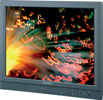

Flat panel monitors based on LCD display technology are rapidly displacing CRT-based designs in a wide range of surveillance and other professional applications.
Occupying less space and consuming less power than their CRT antecedents, LCD monitors deliver flicker-free, high brightness images with perfect picture geometry and enhanced contrast for maximum legibility in a wide range of viewing conditions.
Picture quality and stability aside, LCD technology drives down the lifetime total cost of ownership compared with CRT monitors. Solid-state technology reduces component counts with an accompanying increase in reliability and operational life. Maintenance is cheaper and easier, too. With the need for regular convergence adjustments eliminated, LCD monitors are effectively a 'fit and forget' proposition compared with CRT designs that require regular manual intervention. Unlike CRT monitors, flat panel designs are also immune to electromagnetic field interference, placing fewer demands on positioning and interoperability with other equipment.
With power consumption typically less than half that of CRT designs, energy bills and airconditioning requirements are reduced commensurately: a benefit in cramped control rooms. Since they are smaller, thinner and lighter than their CRT peers, LCD monitors are easier to transport and store.
In a world where we are increasingly preoccupied with conservation of our planet's natural resources, LCD displays are greener on the environment than CRT displays that are designated as hazardous waste by the EU due to their high lead glass content. LCD displays, in contrast, are manufactured using smaller quantities of heavy metals and other hazardous chemicals. This reduces the cost and complexity of disposal as well as minimising overall impact on the environment - an issue that will become increasingly concerning for professional users as new EU legislation relating to the disposal of electronic waste is introduced across many countries.
Benefits of LCD
Developed specifically for the most demanding CCTV and network video monitoring applications where picture quality, consistency and reliability are paramount, new professional LCD monitors (such as the Sony LMD Series of professional LCD monitors) offer several important advantages over flat-panel monitors.
Firstly, they do not employ the noise-reduction circuitry that is often used in domestic TV sets to make less-than-perfect images look 'better' than they really are. While an artificially-enhanced TV picture may look great in the high street showroom, it is little use in quality-critical professional environments where images must be displayed as accurately and naturally as possible.
Secondly, in contrast with LCD displays for PC use that are designed to show predominantly static text and graphics, the design of the latest monitors has been optimised for the accurate display of moving video.
Thirdly, the screen's refresh rate is synchronised to the frame rate of the input video signal - in contrast with PC monitors that typically refresh the screen at a fixed rate, regardless of the frequency of the input signal. This means clearer, flicker-free reproduction of any source.
Lower total cost of ownership
Extended operational life
Solid-state imaging technology reduces component count and power consumption, so LCD displays typically offer a significantly longer lifespan than CRT. In addition, LCD monitors offer more consistent imaging performance throughout their longer operational life, in contrast with CRT designs where light output reduces more rapidly over a more limited lifespan.
Lower maintenance costs
LCD technology eliminates the need for convergence adjustments and is effectively immune to electromagnetic interference - reducing the need for maintenance.
Lower power consumption
LCD monitors consume as little as half the electrical power of an equivalent CRT monitor, significantly reducing energy bills.
Lower airconditioning requirements
Lower power consumption means that LCD monitors generate less heat - a major advantage in confined spaces such as OB vehicles or large studios where airconditioning costs can be reduced.
Lower storage cost
Significant reduction in space allows easy storage and a reduction in storage cost.
Lower transportation costs
LCD monitors are slimmer and far lighter to carry than CRT monitors, reducing labour requirements and shipping costs as well as easing health and safety requirements.
Greener solution
Due to their high lead glass content, CRT displays are designated as hazardous waste by the EU. LCD displays, in contrast, are manufactured using smaller quantities of heavy metals and other hazardous chemicals, reducing the cost of disposal.
Will Klopper is the manager: Professional Products at Sony SA.
For more information contact Will Klopper, Sony Professional SA, +27 (0)11 690 3200, [email protected]

© Technews Publishing (Pty) Ltd. | All Rights Reserved.